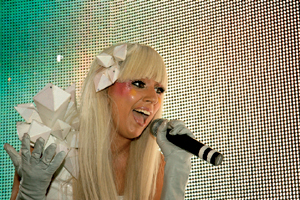Authors: Maureen Callahan
Poker Face (4 page)
In the early-to-mid 1990s, the Lower East Side became just gentrified enough to attract kids from Columbia University and NYU looking to slum it and likely score some really powerful heroin. Ludlow Street was becoming a main artery, with the opening of the venerable dive bar/art space Max Fish; a few doors down was the Alleged Gallery, which showed outsider art and exhibits of skateboard decks, and kept a back room for visiting artists to crash on the floor. (Its founder, Aaron Rose, would later be immortalized as a caddish young playboy on
Gossip Girl,
which one season later featured Lady Gaga in a cameo, performing “Bad Romance” at a school dance.) Cult bands like Jonathan Fire*Eater, which would spawn the more successful Walkmen, were living and playing down there, as was a very young Beck, who could often be found playing coffee shops on Avenue A.
By 2006 the Lower East Side had long been transmogrified into something of a theme park for hipsters. Tourists found their way to Max Fish via Lonely Planet guidebooks, and stars like Jude Law were investors in the infamous grown-up sex house the Box. Famed restauranteur Keith McNally opened Schiller’s, a shabby, sophistiated brasserie serving the likes of Karl Lagerfeld and inspiring the locus of the action in Richard Price’s best-selling 2008 novel,
Lush Life
. The neighborhood is so well branded that an artist like Santigold can release a song called “L.E.S. Artistes,” and not only will it become a hit, but almost everyone who hears it will know what L.E.S. stands for. By the time Stefani took up residence there, the Lower East Side was almost as safe as the Upper West Side, if filthier. But that’s part of the appeal, and this Lower East Side was still where all the cool kids were. Members of the Strokes, Interpol, and Yeah Yeah Yeahs ran around down there; the city’s best music venues, like the Mercury Lounge and the Bowery Ballroom, were there; it was where A&R people scouted new talent, fashion editors sourced trends, and where the bulk of the city’s most-read art and music bloggers lived and worked.
“That period of my life,” Gaga has said, “was about me trying to be cool, being the queen of a very small scene, getting my picture taken, dating the hottest bartender. Bartenders are like movie stars down there.” (As absurd as that may sound, she’s right.) “On the Lower East Side, being Queen of the Scene is like being the queen of two blocks. But it got me in magazines, and it got Interscope”—her future record label—“interested.”
She found a place at 176 Stanton Street, and this was the tiny one-bedroom walk-up that was her part-time home when not decamped with her parents. (She didn’t have a day job; her much-talked-about stint waitressing was during her sophomore to senior years in high school.) On the Lower East Side, too, she made quite the impression: One of her neighbors says that, not long after he moved in, his sister asked him if he knew that “there was a prostitute that lives in the building.”
Her neighbor was totally flummoxed; Stanton Street, like the bulk of the Lower East Side, was mainly inhabited by young scenesters and professionals. “I was like, ‘What are you talking about?’ She said, ‘I saw this girl stumbling up the stairs at, like, four
A.M.
, wearing, like, nothing, and she was drunk.’ And I just remember thinking, ‘Oh, great. What a scummy building I live in now.’ ”
Stefani would spend her days composing and demo-ing at 176 Stanton; her place was sparsely decorated with a futon, a queen-sized mattress, and a record player from Urban Outfitters. She had a picture of David Bowie over her bed and she’d sit at her kitchen counter with her keyboard and her laptop, working out songs.
“She had a bare-ass apartment,” says her friend Brendan Sullivan, who would go on to work as her DJ. “It just had turntables, a synth, and a couch. It was like a monk’s cell—just for work and study.”
Stefani was running around in leotards and go-go boots, stumbling up the stairs at four in the morning, but at heart she was an extremely hard worker who kept to herself. Those who knew her during this time and those who knew her once she’d achieved global fame describe her in very similar terms: a girl with insane levels of charisma, who outwardly seemed very popular and self-possessed, but who was actually very difficult to get to know. In this way, perhaps Gaga’s description of herself as an alienated teenager, the high school “freak” who never fit in, may not be all that far from the truth. It’s possible, after all, to be both popular and alienated. Just watch
Rebel Without a Cause
or
Heathers
or
Gossip Girl
.
In any event, it was the other tenants who caused problems, once dramatically, with Stefani. Her neighbor says that, at one point, some kids who lived in the building “jimmied the lock and broke into her apartment, saw her in the shower—it was a big thing. They all got arrested.” Another neighbor happened to be a cop, and he helped make the arrest.
Recently, her old neighbor got a text from that cop, who wrote, “Remember that girl whose apartment was broken into? Stefani? She was a musician and now she’s Lady Gaga.” It took her old neighbor a while, he says, to believe it. Today, he realizes that the timing of her move out of 176 Stanton—to L.A.—had nothing to do with the break-in, as he’d assumed, and everything to do with the record deal to come.
During her time on the Lower East Side, Stefani would head over to local bars like Welcome to the Johnsons and St. Jerome’s, both of which were managed by a reedy peacock of a rock boy named Lüc, who also worked as a bartender. Once she became Gaga, she said he partially inspired “Paparazzi,” with the actual paparazzi and her ravenous desire for fame inspiring the other half.
Lüc Carl is well over six feet tall and, with long black hair that sprays up from his crown like an unruly fern, looks like a cross between Russell Brand and Nikki Sixx. He doesn’t so much bartend as lope around and drape himself over the bar, staring into space; a customer waits for him to decide if he’s up to making the move to serve you. (The bartender as rock star.) Stefani had her eye on him, but also on a burlesque dancer named Lady Starlight, who worked Fridays at St. Jerome’s. Starlight was another celebrity in the scene, a sweet girl who worked a tough, heavy-metal look, who had gigs at all the right bars and knew all the right kids and could get into all the right parties. Gaga wanted to be Starlight’s friend.
“She was, and is, incredibly focused and motivated about succeeding,” says Starlight, who, back in 2007, with her long black hair, heavy bangs, and misguided dress sense, looked like Stefani’s twin. (In pictures taken of the two of them, it’s hard to figure out who’s who.) She vividly recalls their first meeting, back around 2006: “She tipped me,” Starlight says. “In my panties.”
Stefani got Starlight’s number from Lüc and, just as she’d successfully done with Wendy Starland, began courting her as a best friend. “You couldn’t help but notice her,” says Starlight, who explains that this was not necessarily the best thing. Starlight, who claims to have been born in 1980 but may be ten years older, says that Stefani looked “abrupt and out of place” among the neighborhood’s hipster squad. “She wore spandex, some kind of unitard.”
Fusari also remembers Stefani working out her look during this time. He was shocked at both its unadulterated poor taste and Stefani’s disregard for what anyone else thought. “It started to evolve into this thing. . . . I don’t want to say I started to question it, but I would keep my fingers crossed when she’d show up to meetings,” Fusari says. “I could never tell what she’d wear. The color schemes would be really tight leopard-print pants with one-foot-tall red pumps. I was like, ‘Is this
The Rocky Horror Picture Show
?’ Walking down the street with her, honestly, no exaggeration, 90 percent of people would stop in their tracks. You don’t expect that in New York City. I’d be like, ‘Stef, you gotta walk a little bit ahead of me. People are gonna say I might be with a prostitute. Or a transsexual prostitute.’ It wouldn’t even faze her.”
A friend who met Stefani not long after has a similar recollection: “People would stare,” she says. “She [didn’t look] as insane as she does now, but she was definitely not the average person walking down the street. She would wear these leotards from American Apparel—it was almost like she had her underwear on over her clothes.”
“The big outfit was fishnets and a backless leotard with a chain belt,” says her friend Sullivan, who first met Stefani at St. Jerome’s, where Lüc bartended, in December 2006. “She’d wear that and high heels and a leather jacket. That was her jam.” He recalls her introducing herself as a singer; Sullivan was often spinning at St. Jerome’s. Stefani had just begun dating Lüc; Sullivan says Lüc was extremely possessive.
That night, Sullivan was paying more attention to Stefani than to his date, who he knew Lüc also had a crush on. Sullivan found that amusing. He and Stefani were bonding over music and performing, and they decided to exchange numbers. That was enough, Sullivan says, to set Lüc off, which he still finds really funny.
First, Sullivan says, he was putting her name in his phone, but she told him not to punch in “Stefani.” She told him to use “Gaga.” Lüc was already agitated, and then she got a call. “Lüc goes, ‘Who’s calling you at eleven at night?’ and she goes, ‘My producer,’ ” says Sullivan, laughing. Frustrated, Lüc then turned to Sullivan and yelled, ‘Stop talking to my girlfriend, man!’ ”
He and Lüc got into a bit of a typically pathetic Lower East Side pissing match over who was cooler, more connected, had the more desirable partner. At least, Sullivan says, he had the dignity not to brag that his date had once been involved with Moby, and that Moby hated Sullivan, and how cool was it that an internationally famous musician not only knew who he was but actively disliked him.
Lüc, Sullivan thought, had not yet mastered the difficult, necessary downtown art of seeming not to care—unlike Sullivan, who would
never
bring up the Moby connection. In an attempt to smooth things over, Sullivan told Lüc that Stefani was hot. “And he responded, ‘Island recording artist,’ ” says Sullivan. He was turned off by all of Lüc’s over-compensation.
Lüc aside, Sullivan is still exhilarated by that evening: “So that was the fateful, fateful, awesome meeting that changed my life, and hers, forever,” he says. Because that was the night he met the girl who would become Lady Gaga, and he still can’t believe he knows someone that famous.

A harbinger of things to come: The adorable, attitudinal little girl who would become Lady Gaga, at home in front of her piano, circa 1993.
Seth Poppel/Yearbook Library
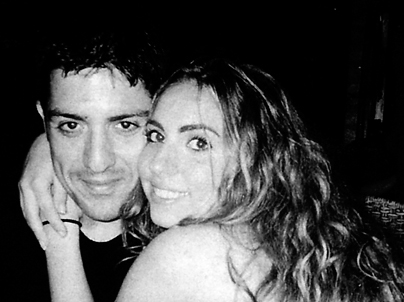
A teenage Stefani, looking every bit the well-manicured, popular Upper West Side teen, hugs an unidentified friend in this 2004 Convent of the Sacred Heart yearbook photo.
Seth Poppel/Yearbook Library
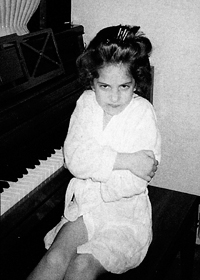
The self-proclaimed teenage “freak” (bottom, far left), with a gaggle of strikingly normal-looking pals, in another shot from her senior high school yearbook.
Seth Poppel/Yearbook Library
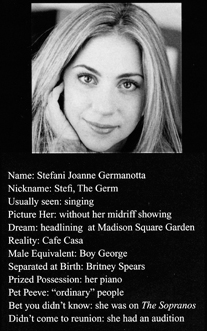
Stefani’s senior-year bio, from her yearbook. Remarkable, no?
Seth Poppel/Yearbook Library
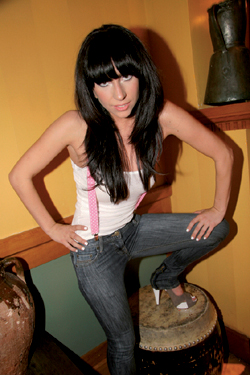
The makeover begins: a markedly thinner Stefani, now Lady Gaga, with black hair and white nails, at the 2007 BMI showcase “Who’s Next? Writers on the Rise.”
Scott McLane / Retna Ltd.
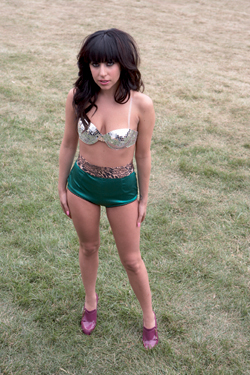
A disco-ball bra, green-stain tap pants with a leopard-print waist, and shiny pink shoes: the ever-gestating Lady Gaga shot at her first big break, Lollapalooza, 2007.
Josie Miner

In her version of beachwear—a skullcap and a vintage Prince and the New Power Generation T-shirt, taken on a rehearsal day for the Miss Universe Pageant 2008 in Vietnam.
David Ciemny
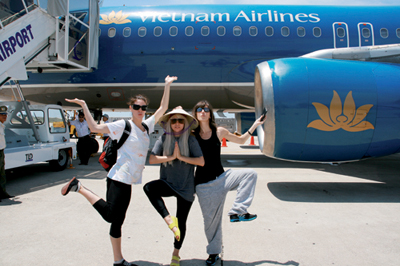
Gaga in a traditional Vietnamese hat, flanked by dancers Melissa Emrico and Celine Thubert, leaving the country after performing on the Miss Universe Pageant 2008.
David Ciemny
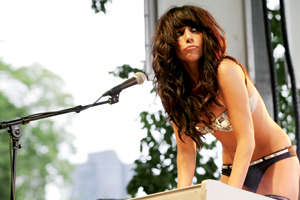
The bra made it, the tap pants didn’t: Lady Gaga onstage at Lollapalooza. Right after this gig, Gaga fired her manager over a record that skipped during this performance.
Jason Squires/WireImage
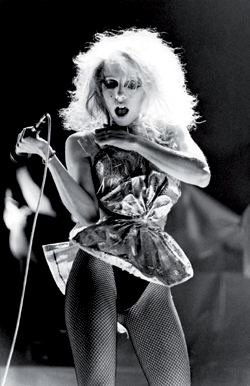
Madonna may be the most-referenced, but Missing Persons’ Dale Bozzio, performing here in 1983, is one of Gaga’s most referenced forebears; there are times when the two look indistinguishable . . .
© Chris Walter / Retna Ltd.
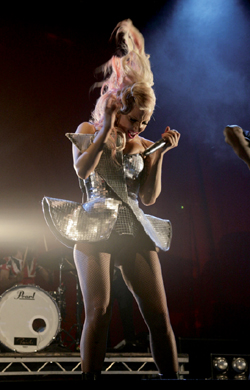
. . . such as here: Gaga references (or rips off, depending on your worldview) the aerodynamic silver minidress, the pink-streaked platinum blond hair, and aggressive stage presence.
Yui Mok/PA Archive/Press Association Images
